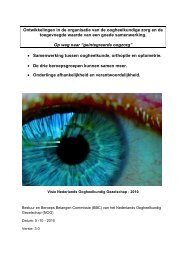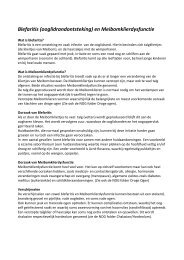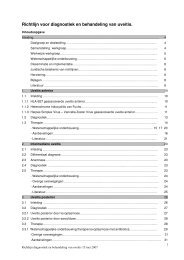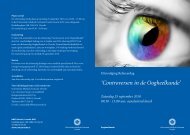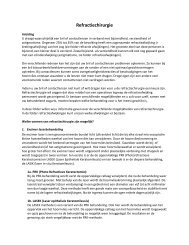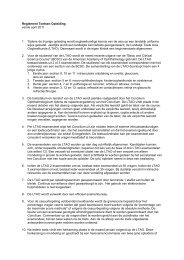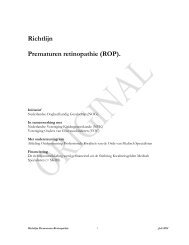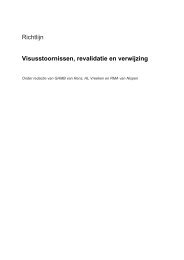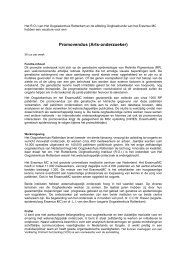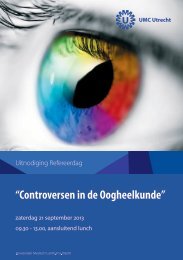terminology and guidelines for glaucoma ii - Kwaliteitskoepel
terminology and guidelines for glaucoma ii - Kwaliteitskoepel
terminology and guidelines for glaucoma ii - Kwaliteitskoepel
You also want an ePaper? Increase the reach of your titles
YUMPU automatically turns print PDFs into web optimized ePapers that Google loves.
central 24 or 30 central degrees respectively. Testing points are aligned 3° off the vertical <strong>and</strong> horizontal meridians in<br />
order to facilitate detection of “nasal steps” field defects.<br />
Octopus Program G1 measures the retinal sensitivity at 73 points. 59 points are in the central 26 degrees (phase 1 <strong>and</strong><br />
2) at full threshold; 14 points are in the periphery, between 30 <strong>and</strong> 60 degrees (phase 3), <strong>and</strong> are tested at suprathreshold<br />
levels.<br />
SITA St<strong>and</strong>ard <strong>and</strong> Fast <strong>for</strong> Humphrey <strong>and</strong> TOP <strong>for</strong> Octopus<br />
Offers the advantage of a short test time.<br />
Available data are promising but need to be confirmed be<strong>for</strong>e this technique is generally applied 1 .<br />
Exams per<strong>for</strong>med with the same instrument but with different strategies should not be used to assess progression.<br />
1.4.2.1.2 - Non conventional techniques<br />
SWAP (Short Wavelength Automated Perimetry) is based on the theory that the yellow light of the background can<br />
reduce the sensitivity of some photoreceptors <strong>and</strong> leave active the blue cones that carry the stimulus using “Parvo” ganglion<br />
cells. It is greatly affected by lens density.<br />
FDT (Frequency doubling technology) is based on the theory that “My “ganglion cells are the first to be involved in<br />
<strong>glaucoma</strong> <strong>and</strong> that using low spatial <strong>and</strong> high temporal frequency stimuli it is possible to detect the loss of these cells.<br />
Motion <strong>and</strong> Flicker perimetry have been applied in clinical research; further developments are pending.<br />
HRP (High Pass Resolution Perimetry) is based on the theory that “Parvo” ganglion cells can be detected particularly<br />
well by high spatial <strong>and</strong> low temporal stimuli. This technology not been widely disseminated.<br />
Available data are promising especially <strong>for</strong> early detection of functional damage. The role of these techniques in the<br />
routine management is yet to be defined 2-10.<br />
1.4.3 - THE EVALUATION OF PERIMETRY EXAMINATION<br />
Possible sources of errors:<br />
• Name: if mistyped the patient can be easily misdiagnosed, <strong>and</strong> the automated analysis of progression during<br />
the follow-up is impossible.<br />
• Date of the exam<br />
• Birthdate: if mistyped patient identification is not possible, <strong>and</strong> the analysis may be incorrect, since<br />
threshold testing takes into account age in the normative database. After the age of 20 there is a loss of differential<br />
light sensitivity of 0.6 dB per decade, which is more pronounced in the peripheral visual field. If a false<br />
lower age is entered, the normal field is evaluated as a field with pathologically low sensitivity; if false higher<br />
age is entered, even pathological visual fields can be evaluated as normal.<br />
• Refraction: the test should be done using near vision correction after the age of 40 or in aphakes <strong>and</strong> pseudophakes.<br />
Astigmatism of more than 1 diopter can produce a refractive temporal peripheral scotoma. If the correcting<br />
lens is not centered, a peripheral scotoma can be observed. Aphakic spectacle correction causes up to<br />
50% of constriction of the visual field (called annular scotoma). An anterior chamber intraocular lens can cause<br />
a slight constriction of the visual field.<br />
• Pupil size: ideally 3.5 to 4 mm. Very small <strong>and</strong> very dilated pupils cause low or high sensitivity, respectively,<br />
which may be misleading both as regards diagnosis <strong>and</strong> the evaluation of progression. If the size of the pupil is<br />
outside the normal range (2 to 4 mm diameter) when the visual field is tested, the influence of the pupil-size<br />
must be considered.<br />
• Strategy / method / program: Differences between the algorithms used <strong>for</strong> sensitivity testing <strong>and</strong> processing<br />
cause differences in the indices shown in the report. This must be considered when the visual field is evaluated.<br />
In general, shorter programs (Humphrey, SITA, Octopus TOP Dynamic test) show better sensitivity (i.e. smaller<br />
MD) than conventional, longer programs (e.g. Humphrey full threshold test or OCTOPUS normal strategy).<br />
• Duration of the test: approximately 15 minutes per eye. Poor reliability should be suspected if the test time is<br />
too long. In these cases a shorter test should be considered. Fatigue can be responsible <strong>for</strong> false visual field defects<br />
Ch. 1 - 25 EGS



